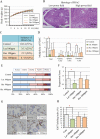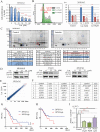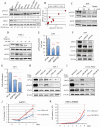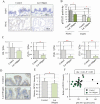DPYD, down-regulated by the potentially chemopreventive agent luteolin, interacts with STAT3 in pancreatic cancer
- PMID: 33640964
- PMCID: PMC8283735
- DOI: 10.1093/carcin/bgab017
DPYD, down-regulated by the potentially chemopreventive agent luteolin, interacts with STAT3 in pancreatic cancer
Abstract
The 5-year survival rate of pancreatic ductal carcinoma (PDAC) patients is <10% despite progress in clinical medicine. Strategies to prevent the development of PDAC are urgently required. The flavonoids Luteolin (Lut) and hesperetin (Hes) may be cancer-chemopreventive, but effects on pancreatic carcinogenesis in vivo have not been studied. Here, the chemopreventive effects of Lut and Hes on pancreatic carcinogenesis are assessed in the BOP-induced hamster PDAC model. Lut but not Hes suppressed proliferation of pancreatic intraepithelial neoplasia (PanIN) and reduced the incidence and multiplicity of PDAC in this model. Lut also inhibited the proliferation of hamster and human pancreatic cancer cells in vitro. Multi-blot and microarray assays revealed decreased phosphorylated STAT3 (pSTAT3) and dihydropyrimidine dehydrogenase (DPYD) on Lut exposure. To explore the relationship between DPYD and STAT3 activity, the former was silenced by RNAi or overexpressed using expression vectors, and the latter was inactivated by small molecule inhibitors or stimulated by IL6 in human PDAC cells. DPYD knock-down decreased, and overexpression increased, pSTAT3 and cell proliferation. DPYD expression was decreased by inactivation of STAT3 and increased by its activation. The frequency of pSTAT3-positive cells and DPYD expression was significantly correlated and was decreased in parallel by Lut in the hamster PDAC model. Finally, immunohistochemical analysis in 73 cases of human PDAC demonstrated that DPYD expression was positively correlated with the Ki-67 labeling index, and high expression was associated with poor prognosis. These results indicate that Lut is a promising chemopreventive agent for PDAC, targeting a novel STAT3-DPYD pathway.
© The Author(s) 2021. Published by Oxford University Press.
Figures





Similar articles
-
The role of DPYD and the effects of DPYD suppressor luteolin combined with 5-FU in pancreatic cancer.Cancer Med. 2024 Aug;13(16):e70124. doi: 10.1002/cam4.70124. Cancer Med. 2024. PMID: 39158384 Free PMC article.
-
Pancreatic stellate cell secreted IL-6 stimulates STAT3 dependent invasiveness of pancreatic intraepithelial neoplasia and cancer cells.Oncotarget. 2016 Oct 4;7(40):65982-65992. doi: 10.18632/oncotarget.11786. Oncotarget. 2016. PMID: 27602757 Free PMC article.
-
Cotargeting of MEK and PDGFR/STAT3 Pathways to Treat Pancreatic Ductal Adenocarcinoma.Mol Cancer Ther. 2017 Sep;16(9):1729-1738. doi: 10.1158/1535-7163.MCT-17-0009. Epub 2017 Jun 15. Mol Cancer Ther. 2017. PMID: 28619758
-
STAT3 signaling in pancreatic ductal adenocarcinoma: a candidate therapeutic target.Pathol Res Pract. 2023 May;245:154425. doi: 10.1016/j.prp.2023.154425. Epub 2023 Mar 24. Pathol Res Pract. 2023. PMID: 37019018 Review.
-
Agonists of galanin subtype 2 receptor may prevent pancreatic cancer and agonists of angiotensin II type 2 receptor may prevent colorectal cancer.Eur J Pharmacol. 2024 Sep 5;978:176772. doi: 10.1016/j.ejphar.2024.176772. Epub 2024 Jun 24. Eur J Pharmacol. 2024. PMID: 38925290 Review.
Cited by
-
Luteolin, a Potent Anticancer Compound: From Chemistry to Cellular Interactions and Synergetic Perspectives.Cancers (Basel). 2022 Oct 31;14(21):5373. doi: 10.3390/cancers14215373. Cancers (Basel). 2022. PMID: 36358791 Free PMC article. Review.
-
DPYD Exome, mRNA Expression and Uracil Levels in Early Severe Toxicity to Fluoropyrimidines: An Extreme Phenotype Approach.J Pers Med. 2021 Aug 13;11(8):792. doi: 10.3390/jpm11080792. J Pers Med. 2021. PMID: 34442436 Free PMC article.
-
Myocyte enhancer factor 2D promotes hepatocellular carcinoma through AMOTL2/YAP signaling that inhibited by luteolin.Int J Clin Exp Pathol. 2022 May 15;15(5):206-214. eCollection 2022. Int J Clin Exp Pathol. 2022. PMID: 35698637 Free PMC article.
-
Revisiting luteolin: An updated review on its anticancer potential.Heliyon. 2024 Feb 20;10(5):e26701. doi: 10.1016/j.heliyon.2024.e26701. eCollection 2024 Mar 15. Heliyon. 2024. PMID: 38455556 Free PMC article. Review.
-
Updated Review on Natural Polyphenols: Molecular Mechanisms, Biological Effects, and Clinical Applications for Cancer Management.Biomolecules. 2025 Apr 28;15(5):629. doi: 10.3390/biom15050629. Biomolecules. 2025. PMID: 40427522 Free PMC article. Review.
References
-
- Ministry of Health, Labour and Welfare. (2017) Vital Statistics Japan.
-
- Benzel, J., et al. (2018) Chemoprevention and treatment of pancreatic cancer: update and review of the literature. Digestion, 97, 275–287. - PubMed
Publication types
MeSH terms
Substances
Grants and funding
LinkOut - more resources
Full Text Sources
Other Literature Sources
Medical
Research Materials
Miscellaneous

